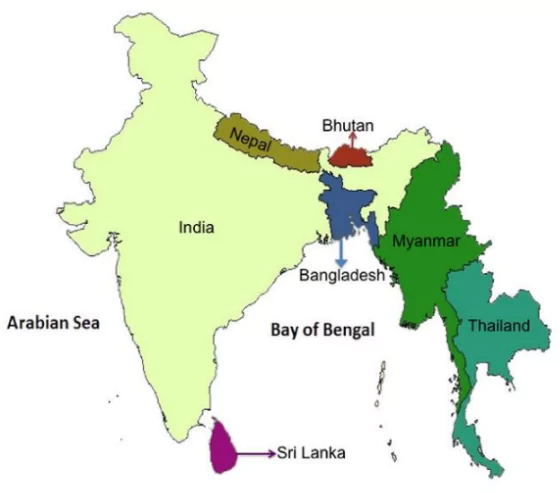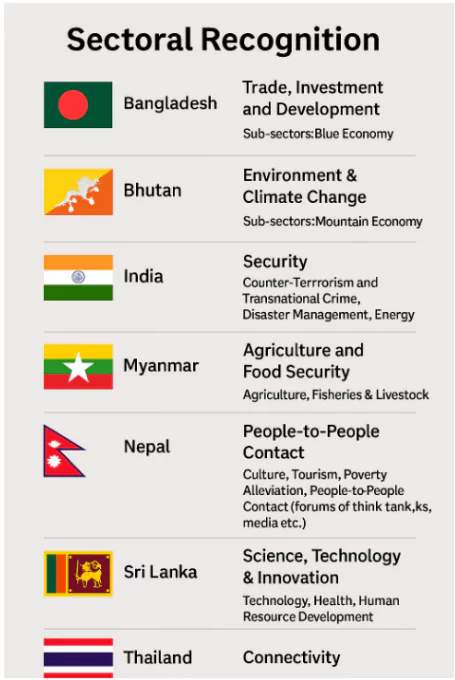Prime Minister Narendra Modi participated in the 6th BIMSTEC Summit hosted by Thailand, the current chair, under the theme— “BIMSTEC: Prosperous, Resilient and Open”.
- The Prime Minister Shri Narendra Modi proposed a 21-point Action Plan covering different aspects of cooperation among the BIMSTEC nations
- During his visit, PM Modi was presented with The World Tipitaka: Sajjhaya Phonetic Edition by Thai Prime Minister Paetongtarn Shinawatra.
India-Led Initiatives Announced

- Business: Establishment of BIMSTEC Chamber of Commerce.
- Organization of BIMSTEC Business Summit every year.
- Feasibility study on the possibilities of trade in local currency in the BIMSTEC region.
- IT: Pilot study to understand the needs of BIMSTEC countries to share the experience of Digital Public Infrastructure (DPI)
- Connectivity between UPI and payment systems in the BIMSTEC region.
- Mitigation and Disaster Management: Establishing the BIMSTEC Centre of Excellence for Disaster Management in India to cooperate in disaster management, relief and rehabilitation.
- Fourth joint exercises between BIMSTEC Disaster Management Authorities to be held in India this year.
- Security: Holding the first meeting of the Home Ministers’ Mechanism in India
- Capacity Building and Training: “BODHI”, i.e., “BIMSTEC for Organised Development of Human resource Infrastructure” initiative. Under this, 300 youth from BIMSTEC countries will be trained in India every year.
- Scholarships to BIMSTEC students in the Forestry Research Institute of India and expansion of the scholarship scheme at Nalanda University.
- Energy: BIMSTEC Energy Centre in Bengaluru has started working.
- Faster work on electric grid interconnection.
- Youth engagement: BIMSTEC Young Leaders’ Summit to be held this year.
- The BIMSTEC Hackathon and Young Professional Visitors programme will be launched.
- Sports: Holding ‘BIMSTEC Athletics Meet’ in India this year.
- Hosting the first BIMSTEC Games in 2027
- Culture: BIMSTEC Traditional Music Festival to be held in India this year
- Connectivity: Establishment of Sustainable Maritime Transport Centre in India to work to enhance coordination in capacity building, research, innovation and maritime policies.
About Tipitaka
- The Tripitaka, meaning “Three Baskets” in Sanskrit, is the foundational collection of Buddhist scriptures, traditionally divided into three parts:
- Vinaya Pitaka: Contains the rules and regulations for monastic life, outlining the conduct and discipline expected of monks and nuns.
- Sutta Pitaka: Comprises the discourses and teachings of the Buddha, including sermons and narratives.
- Abhidhamma Pitaka: Delves into philosophical and psychological analyses of Buddhist doctrines.
- Significance: The Tripitaka is considered a foundational source for Buddhist practice and scholarship, serving to preserve and disseminate the Buddha’s teachings.
- Pali Canon: Also known as the Pali Canon, particularly in Theravada Buddhism.
|
Key Agreements & Documents Adopted
- Summit Declaration: Captures the shared vision, priorities, and commitments of member states.
- Sets the tone for future cooperation under the theme: “Prosperous, Resilient, and Open BIMSTEC”.
- BIMSTEC Bangkok Vision 2030: A comprehensive roadmap for the next 5 years.
- Aligned with:
- UN Sustainable Development Goals (SDGs)
- Thailand’s Bio-Circular-Green (BCG) Economic Model
- Focused on:
- Prosperity: Trade, poverty alleviation, sustainable development.
- Resilience: Agriculture, public health, disaster preparedness.
- Openness: Tourism, connectivity, inclusiveness.
- BIMSTEC Maritime Transport Cooperation Agreement
- Aims to enhance:
- Cargo and passenger movement across Bay of Bengal.
- Recognition of documents and certificates of vessels, crew, and cargo.
- Establishment of a Joint Shipping Coordination Committee.
- Provides a structured dispute resolution mechanism.
- Rules of Procedure for BIMSTEC Mechanisms: Complements the BIMSTEC Charter (2022).
- Enhances institutional clarity, decision-making, and functional coherence of BIMSTEC working bodies.
- MoUs with International Organizations:
- Indian Ocean Rim Association (IORA): Expands BIMSTEC’s external cooperation on maritime and blue economy sectors.
- United Nations Office on Drugs and Crime (UNODC): Strengthens collaboration in Counter-narcotics, Criminal justice reform, and Transnational crime prevention.
- Approval of Eminent Persons Group (EPG) report: Offers strategic recommendations for: Institutional reform, Sectoral prioritization, Long-term visioning for BIMSTEC.
- Finalized after regional consultations in 2024.
BIMSTEC (Bay of Bengal Initiative for Multi-Sectoral Technical and Economic Cooperation)
About BIMSTEC
- BIMSTEC is a multilateral regional organization established with the aim of accelerating shared growth and cooperation between littoral and adjacent countries in the Bay of Bengal region.
- It was founded as BIST-EC, in June 1997, with the adoption of the Bangkok Declaration, with Bangladesh, India, Sri Lanka and Thailand as members.
- It became BIMST-EC (Bangladesh, India, Myanmar, Sri Lanka and Thailand Economic Cooperation) with the entry of Myanmar in late 1997,
- And eventually, it was named in its current form, when Nepal and Bhutan became members in 2004.
- Represents around 1.7 billion people (22% of the global population) and a combined GDP of approximately USD 4.5 trillion.
- Permanent Secretariat: Dhaka, Bangladesh.
- Membership: It has a total of seven member countries:
- Five from South Asia, including Bangladesh, Bhutan, India, Nepal, and Sri Lanka;
- Two from Southeast Asia, including Myanmar and Thailand.
- Chairmanship: The BIMSTEC uses the alphabetical order for the Chairmanship.
-
- Currently, Thailand; it will be taken over by Bangladesh.
Significance of BIMSTEC for India
- Strategic Importance: BIMSTEC nations form a bridge between South Asia and Southeast Asia, central to India’s Act East Policy.
- India–Myanmar–Thailand Trilateral Highway is a flagship connectivity initiative under BIMSTEC aimed at linking India’s Northeast with ASEAN nations.
- Alternative to SAARC: BIMSTEC excludes Pakistan, enabling smoother cooperation without bilateral tensions.
- SAARC has not held a summit since 2014, while BIMSTEC has held four summits since 2016 and adopted a Charter in 2022, giving it legal personality.
- Enhanced Connectivity & Northeast Integration: Projects like the Kaladan Multi-Modal Transit Transport Project and the BBIN Motor Vehicle Agreement aim to connect India’s northeast with BIMSTEC nations.
- BIMSTEC Master Plan for Transport Connectivity has been adopted and a Maritime Transport Agreement signed in 2025 to boost regional integration.
- Energy & Blue Economy Cooperation: India hosts the BIMSTEC Energy Centre in Bengaluru, and work has begun on electric grid interconnection to facilitate cross-border power trade.
- India and Myanmar lead renewable energy cooperation; India is also involved in sustainable maritime transport and blue economy initiatives.
- Security & Disaster Management: India leads BIMSTEC in Counter-Terrorism, Cybersecurity, and Disaster Management sectors.
- Hosted 4th joint Disaster Management Exercise and proposed a Centre of Excellence for Disaster Management in 2025.
- Trade & Economic Integration: Aims to boost intra-regional trade through the long-pending BIMSTEC Free Trade Agreement (FTA) and economic corridors..
- India proposed the annual BIMSTEC Business Summit, a Chamber of Commerce, and feasibility studies for local currency trade in 2025.
- Cultural Diplomacy & Youth Engagement: India is investing in soft power tools through BIMSTEC Young Leaders’ Summit, BIMSTEC Hackathon, Athletics Meet (2025), BIMSTEC Games (2027), Traditional Music Festival.
- Also announced, 300 youth trained annually under the “BODHI” programme and scholarships at Nalanda University.
How BIMSTEC is Different from SAARC
- Geopolitical Scope & Strategic Value: BIMSTEC bridges South and Southeast Asia, aligning with India’s Act East Policy.
- SAARC is confined to South Asia and remains inactive due to India–Pakistan tensions.
- Membership Composition: BIMSTEC has 7 members, excluding Pakistan, which removes political deadlock.
- SAARC includes Pakistan, often blocking consensus and cooperation.
- Functional vs Political Orientation: BIMSTEC focuses on functional cooperation in 7 sectors like connectivity, trade, disaster management.
- SAARC is often held hostage to political rivalry, especially between India and Pakistan.
- Performance & Summits: BIMSTEC held 4 summits since 2016, with the latest in 2025.
- SAARC has not met since 2014, effectively paralyzed.
- Indian Foreign Minister S. Jaishankar termed SAARC a “jammed vehicle” after the 2016 Uri attack stalled its momentum.
- Sectoral Leadership & Reforms: BIMSTEC has restructured sectors with each member leading one (e.g., India leads Security, Thailand – Connectivity).
- SAARC lacks such structured sectoral responsibility or reforms.
- India’s Role & Acceptance: India’s leadership is welcomed in BIMSTEC.
- In SAARC, India’s dominance is often resisted, especially by Pakistan.
- Emerging as Preferred Platform: With its focus on connectivity, trade, security, and exclusion of disruptive politics.
- BIMSTEC is emerging as the more effective alternative to SAARC.
|
Challenges in BIMSTEC
- Slow Implementation of Agreements & Projects: Despite the FTA being signed in 2004, it remains unimplemented, showing a significant gap between vision and action.
- Several connectivity projects, including the Trilateral Highway and Kaladan Project, have seen repeated delays due to funding, land acquisition, and political issues.
- Weak Institutional Capacity: The BIMSTEC Secretariat in Dhaka is understaffed and underfunded, limiting coordination and policy implementation.
- Lack of a permanent funding mechanism hinders large-scale regional initiatives and infrastructure development.
- Over-Reliance on Political Consensus: BIMSTEC functions on a consensus-based model, which, while inclusive, often results in policy paralysis—especially on contentious issues like security or border disputes.
- Inter-Member Political Differences: Myanmar’s political instability and civil conflict post-2021 coup have raised questions about member alignment and human rights concerns.
- Bilateral tensions (e.g., between Myanmar–Bangladesh, or India–Nepal border issues) occasionally affect multilateral cohesion.
- Low Intra-Regional Trade: Intra-BIMSTEC trade remains below 10%, despite ambitious integration goals and repeated pushes for the FTA and trade facilitation agreements.
- Limited Visibility and Public Awareness: BIMSTEC lacks the public diplomacy and brand visibility of other regional groups like ASEAN.
- People-to-people links remain weak despite India’s efforts (e.g., festivals, scholarships), and private sector involvement is still minimal.
- Competing Regional Platforms: Nations like Thailand and Myanmar are also part of ASEAN, and Bangladesh has growing ties with China via the Belt and Road Initiative (BRI).
- BIMSTEC risks being overshadowed by better-funded and more active platforms.
Major Initiatives by BIMSTEC

- Institutional Framework & Charter: BIMSTEC Charter adopted at the 5th Summit (Colombo, 2022), grants legal personality and formal structure.
- Adoption of Rules of Procedure at 6th Summit (Bangkok, 2025) to streamline the functioning of bodies and meetings.
- Sectoral Reorganisation: Earlier 14 sectors reduced to 7 priority sectors for more focused cooperation in 2022.
- BIMSTEC Master Plan for Transport Connectivity: Adopted in 2022 to enhance multi-modal regional transport networks.
- Involved in:
- Kaladan Multi-modal Transit Project
- India-Myanmar-Thailand Trilateral Highway
- Maritime and Port Connectivity Initiatives
- BIMSTEC Maritime Transport Cooperation Agreement (2025): Signed at the 6th Summit (Bangkok).
- Provisions include: National treatment to vessels, Joint Shipping Coordination Committee, Mutual recognition of seafarer certificates, Dispute resolution framework.
- BIMSTEC Conclave of Ports (2019, India): Organized to promote Port-to-port linkages, Maritime logistics cooperation and Blue Economy initiatives
- BIMSTEC Coastal Shipping Agreement (Drafted): Seeks to reduce logistics cost and time.
- Aims to ease short-sea shipping between littoral states in the Bay of Bengal
- BIMSTEC Free Trade Area Framework Agreement (BFTAFA): Signed in 2004, though not yet implemented.
- Forms the legal foundation for Trade in goods and services, Investment cooperation and Trade facilitation and standards harmonization.
- Security and Counter-Terrorism Cooperation
- BIMSTEC Working Groups on Counter-terrorism & transnational crimes, Maritime security, and Cyber security.
- MILEX-18: First joint military field exercise among BIMSTEC nations (hosted by India in 2018).
- Regular meetings of National Security Chiefs to coordinate responses to regional threats.
- Energy Grid Integration: MoU for establishing the BIMSTEC Grid Interconnection was signed in 2018, during the Fourth BIMSTEC Summit in Kathmandu, Nepal,
- Aiming to facilitate electricity trade and promote regional energy cooperation.
- BIMSTEC Energy Centre located in Bengaluru, India but functions for all members
- Disaster Management Framework: Institutionalized after the 2004 tsunami and repeated cyclones.
- Includes:
- BIMSTEC Disaster Management Exercises (DMEx)
- Creation of standard operating procedures
- Joint early warning and risk reduction efforts
Way Forward for BIMSTEC
- Accelerate Implementation of Agreements: Expedite long-pending initiatives like the BIMSTEC Free Trade Agreement (BFTAFA) and the Coastal Shipping Agreement.
- Adopt binding timelines and performance monitoring to move from intent to execution.
- Strengthen Institutional Capacity: Augment the BIMSTEC Secretariat in Dhaka with more staff, expertise, and budgetary autonomy.
- Establish permanent working groups for key sectors and consider setting up a dedicated BIMSTEC Development Fund.
- Enhance Connectivity on Multiple Fronts: Ensure timely implementation of the Master Plan for Transport Connectivity.
- Integrate digital infrastructure, cross-border power grids, and data exchange platforms to build a seamless economic zone.
- Promote Inclusive & Participatory Regionalism: Actively engage civil society, private sector, think tanks, and academia through Track 1.5 and Track 2 dialogues.
- Institutionalize annual Youth Conclaves, Business Forums, and Tech Summits.
- Focus on Sectoral Cooperation for Regional Resilience: Expand collaboration in public health, climate change, agriculture, and disaster risk reduction.
- Operationalize Centres of Excellence in areas like disaster management, agriculture, and traditional medicine.
- Deepen Security Collaboration with Trust and Transparency: Strengthen cooperation on counter-terrorism, cybersecurity, and maritime security through joint training, intelligence sharing, and capacity building.
- Build a Shared Regional Identity: Promote people-to-people linkages through culture, sports, and education.
-
- Leverage initiatives like the BIMSTEC Games (2027), Music Festivals, and BODHI programme to foster a sense of community across the Bay of Bengal region.
Conclusion
The 6th BIMSTEC Summit highlights India’s proactive role in strengthening regional integration through strategic initiatives, capacity-building programs, and fostering robust people-to-people connections, aligning with India’s vision of shared prosperity, security, and sustainable growth in the Indo-Pacific region.
![]() 5 Apr 2025
5 Apr 2025


